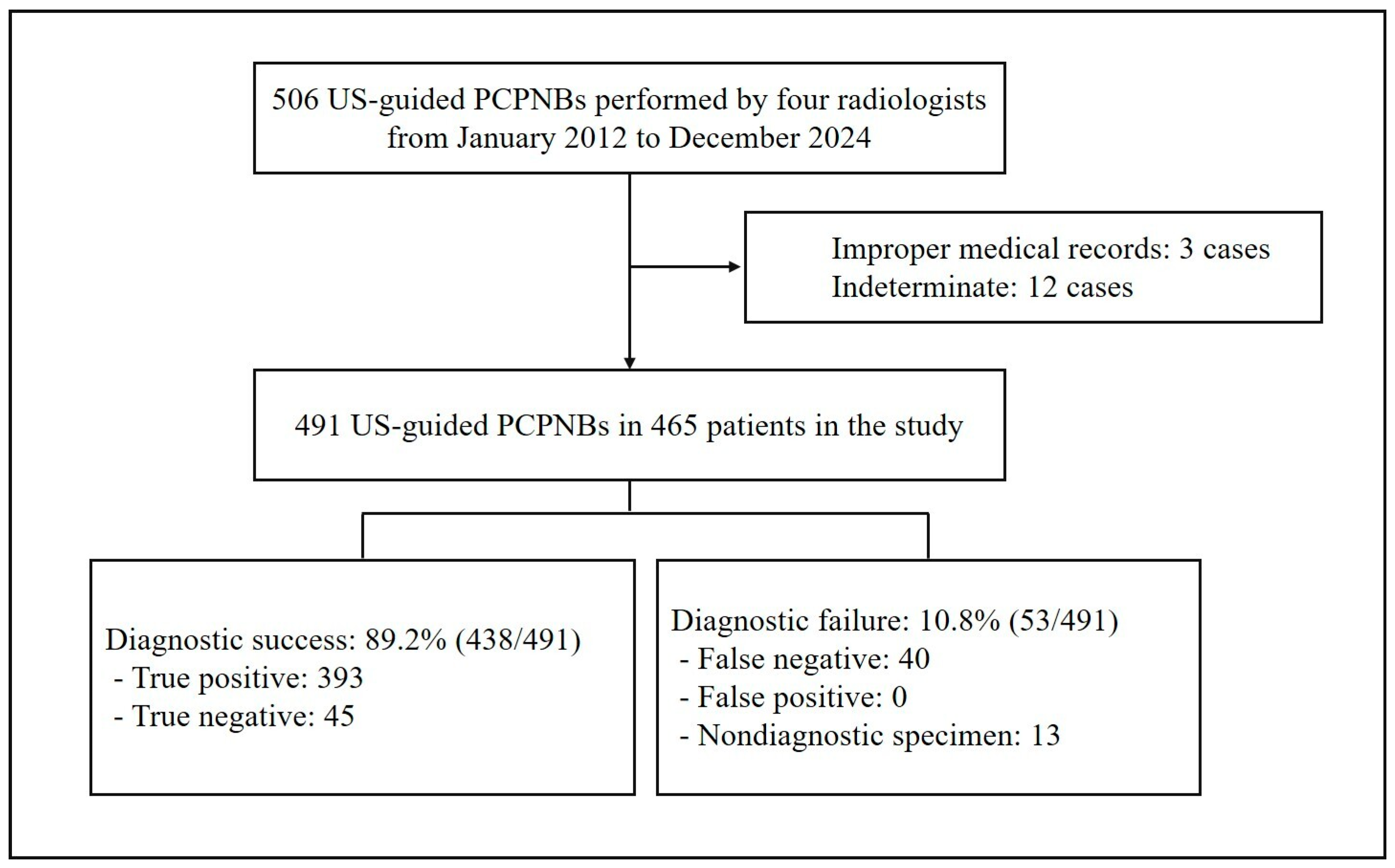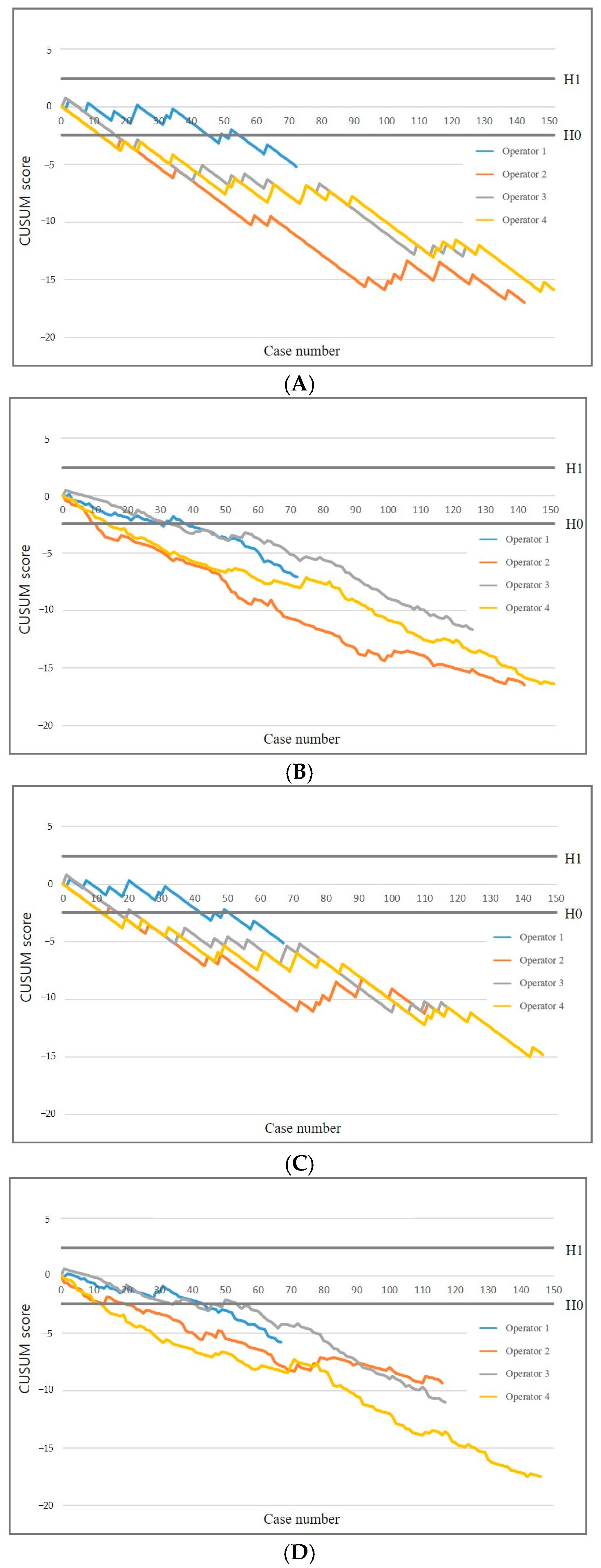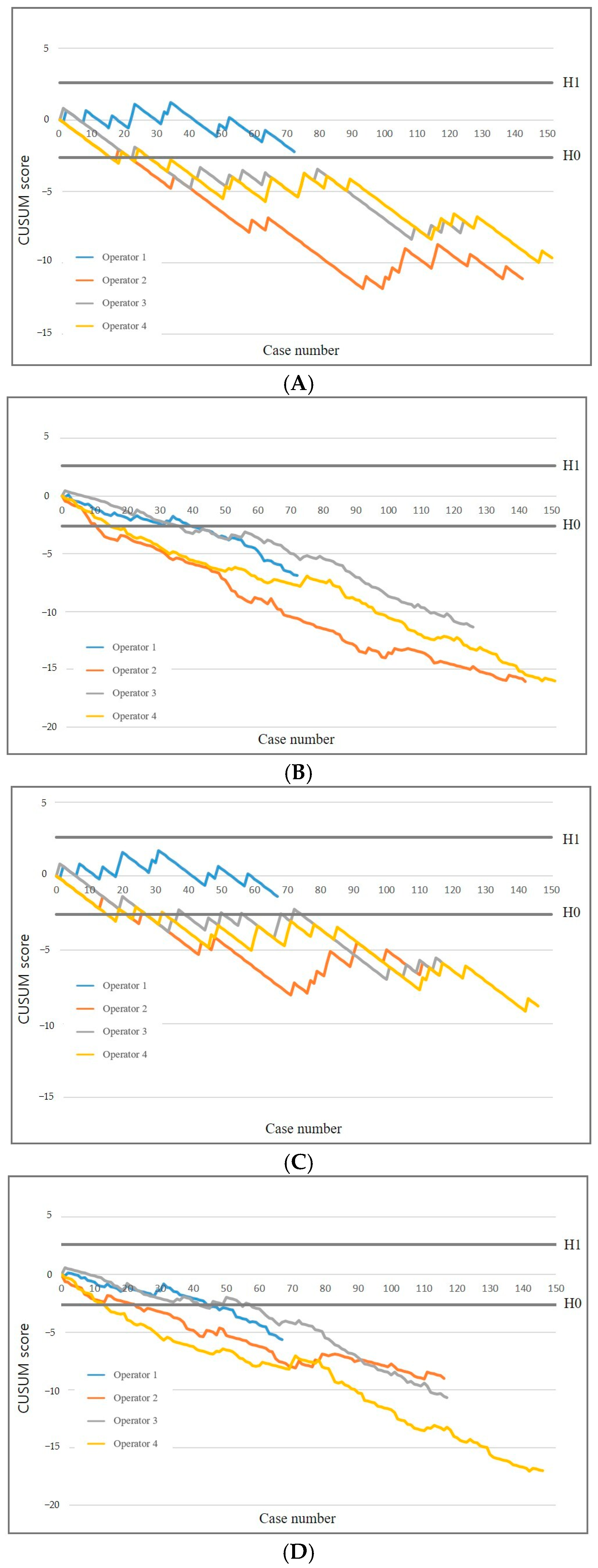Learning Curve of Ultrasound-Guided Percutaneous Needle Biopsy for Pleural Lesions: A Retrospective Study at Two Tertiary Referral Hospitals
Abstract
1. Introduction
2. Materials and Methods
2.1. Patients
2.2. Biopsy Procedure
2.3. Outcome Assessment
2.4. Statistical Analysis
3. Results
3.1. Patient and Lesion Characteristics
3.2. Learning Curves for Diagnostic Performance
3.3. Complication Occurrence
4. Discussion
Supplementary Materials
Author Contributions
Funding
Institutional Review Board Statement
Informed Consent Statement
Data Availability Statement
Conflicts of Interest
References
- Bødtger, U.; Halifax, R.J. Epidemiology: Why is pleural disease becoming more common? In Pleural Disease; European Respiratory Society: Lausanne, Switzerland, 2020; pp. 1–12. [Google Scholar]
- Leung, A.N.; Müller, N.; Miller, R.R. CT in differential diagnosis of diffuse pleural disease. AJR Am. J. Roentgenol. 1990, 154, 487–492. [Google Scholar] [CrossRef] [PubMed]
- Jany, B.; Welte, T. Pleural effusion in adults—Etiology, diagnosis, and treatment. Dtsch. Ärzteblatt Int. 2019, 116, 377. [Google Scholar] [CrossRef] [PubMed]
- Lee, P.; Hsu, A.; Lo, C.; Colt, H.G. Prospective evaluation of flex-rigid pleuroscopy for indeterminate pleural effusion: Accuracy, safety and outcome. Respirology 2007, 12, 881–886. [Google Scholar] [CrossRef] [PubMed]
- Boy, D.; Shaw, J.A.; Koegelenberg, C.F.N. Ultrasound-guided pleural biopsy. Eurasian J. Pulmonol. 2023, 25, 1. [Google Scholar] [CrossRef]
- Mei, F.; Bonifazi, M.; Rota, M.; Cirilli, L.; Grilli, M.; Duranti, C.; Zuccatosta, L.; Bedawi, E.O.; McCracken, D.; Gasparini, S. Diagnostic yield and safety of image-guided pleural biopsy: A systematic review and meta-analysis. Respiration 2021, 100, 77–87. [Google Scholar] [CrossRef]
- Park, J.; Park, B.; Lim, J.-K.; Shin, K.M.; Lee, J.; Kim, C.H.; Seo, H.; Lee, Y.H.; Heo, J.; Do, Y.W. Ultrasound-guided percutaneous needle biopsy for small pleural lesions: Diagnostic yield and impact of CT and ultrasound characteristics. Am. J. Roentgenol. 2021, 217, 699–706. [Google Scholar] [CrossRef]
- Corcoran, J.P.; Tazi-Mezalek, R.; Maldonado, F.; Yarmus, L.B.; Annema, J.T.; Koegelenberg, C.F.; St Noble, V.; Rahman, N.M. State of the art thoracic ultrasound: Intervention and therapeutics. Thorax 2017, 72, 840–849. [Google Scholar] [CrossRef]
- Sconfienza, L.M.; Mauri, G.; Grossi, F.; Truini, M.; Serafini, G.; Sardanelli, F.; Murolo, C. Pleural and peripheral lung lesions: Comparison of US-and CT-guided biopsy. Radiology 2013, 266, 930–935. [Google Scholar] [CrossRef]
- Ahn, S.Y.; Park, C.M.; Yoon, S.H.; Kim, H.; Goo, J.M. Learning curve of C-arm cone-beam computed tomography virtual navigation-guided percutaneous transthoracic needle biopsy. Korean J. Radiol. 2019, 20, 844–853. [Google Scholar] [CrossRef]
- Park, R.; Lee, S.M.; Kim, S.; Park, S.; Choe, J.; Do, K.-H.; Seo, J.B. Learning curve for CT-guided percutaneous transthoracic needle biopsy: Retrospective evaluation among 17 thoracic imaging fellows at a tertiary referral hospital. Am. J. Roentgenol. 2022, 218, 112–123. [Google Scholar] [CrossRef]
- Page, E.S. Continuous inspection schemes. Biometrika 1954, 41, 100–115. [Google Scholar] [CrossRef]
- Westheim, B.H.; Aagenæs, I.; Østensen, A.B.; Sanengen, T.; Almaas, R. Effect of operator experience and frequency of procedure performance on complication rate after ultrasound-guided percutaneous liver biopsies. J. Pediatr. Gastroenterol. Nutr. 2013, 57, 638–643. [Google Scholar] [CrossRef] [PubMed]
- Laursen, C.; Naur, T.M.H.; Bodtger, U.; Konge, L.; Henriksen, D.P.; Colella, S.; Naqibullah, M.; Minddal, V.; Davidsen, J.R.; Hansen, N.C. Learning Curves for Ultrasound Guided Lung Biopsy in the Hands of Respiratory Physicians; European Respiratory Society: Lausanne, Switzerland, 2016. [Google Scholar]
- Ferguson, C.; Winters, S.; Jackson, S.; McToal, M.; Low, G. A retrospective analysis of complication and adequacy rates of ultrasound-guided native and transplant non-focal renal biopsies. Abdom. Radiol. 2018, 43, 2183–2189. [Google Scholar] [CrossRef] [PubMed]
- Sacks, D. Society of interventional radology clinical practice guidelines. J. Vasc. Interv. Radiol. 2003, 14, S199–S202. [Google Scholar] [CrossRef] [PubMed]
- Bolsin, S.; Colson, M. The use of the Cusum technique in the assessment of trainee competence in new procedures. Int. J. Qual. Health Care 2000, 12, 433–438. [Google Scholar] [CrossRef]
- Sheth, R.A.; Baerlocher, M.O.; Connolly, B.L.; Dariushnia, S.R.; Shyn, P.B.; Vatsky, S.; Tam, A.L.; Gupta, S. Society of interventional radiology quality improvement standards on percutaneous needle biopsy in adult and pediatric patients. J. Vasc. Interv. Radiol. 2020, 31, 1840–1848. [Google Scholar] [CrossRef]
- Wang, J.; Zhou, X.; Xie, X.; Tang, Q.; Shen, P.; Zeng, Y. Combined ultrasound-guided cutting-needle biopsy and standard pleural biopsy for diagnosis of malignant pleural effusions. BMC Pulm. Med. 2016, 16, 155. [Google Scholar] [CrossRef]
- Hallifax, R.J.; Corcoran, J.P.; Ahmed, A.; Nagendran, M.; Rostom, H.; Hassan, N.; Maruthappu, M.; Psallidas, I.; Manuel, A.; Gleeson, F.V. Physician-based ultrasound-guided biopsy for diagnosing pleural disease. Chest 2014, 146, 1001–1006. [Google Scholar] [CrossRef]
- Zhang, Q.; Deng, M.-M.; Li, X.-L.; Lu, Y.; Hou, G. Thoracic ultrasound-guided real-time pleural biopsy in the diagnosis of pleural diseases: A systematic review and meta-analysis. Expert Rev. Respir. Med. 2023, 17, 805–813. [Google Scholar] [CrossRef]
- Dessolle, L.; Fréour, T.; Barrière, P.; Jean, M.; Ravel, C.; Daraï, E.; Biau, D.J. How soon can I be proficient in embryo transfer? Lessons from the cumulative summation test for learning curve (LC-CUSUM). Hum. Reprod. 2010, 25, 380–386. [Google Scholar] [CrossRef]
- Komatsu, R.; Kasuya, Y.; Yogo, H.; Sessler, D.I.; Mascha, E.; Yang, D.; Ozaki, M. Learning curves for bag-and-mask ventilation and orotracheal intubation: An application of the cumulative sum method. Anesthesiology 2010, 112, 1525–1531. [Google Scholar] [CrossRef] [PubMed]
- Kemp, S.; El Batrawy, S.; Harrison, R.; Skwarski, K.; Munavvar, M.; Roselli, A.; Cusworth, K.; Shah, P. Learning Curves for Endobronchial Ultrasound Using Cusum Analysis; BMJ Publishing Group Ltd.: London, UK, 2010. [Google Scholar][Green Version]
- Kim, J.H.; Butler, J.P.; Loring, S.H. Influence of the softness of the parietal pleura on respiratory sliding mechanisms. Respir. Physiol. Neurobiol. 2011, 177, 114–119. [Google Scholar] [CrossRef] [PubMed]
- Chevallier, P.; Ruitort, F.; Denys, A.; Staccini, P.; Saint-Paul, M.C.; Ouzan, D.; Motamedi, J.P.; Tran, A.; Schnyder, P.; Bruneton, J.N. Influence of operator experience on performance of ultrasound-guided percutaneous liver biopsy. Eur. Radiol. 2004, 14, 2086–2091. [Google Scholar] [CrossRef] [PubMed]
- Yamamoto, N.; Watanabe, T.; Yamada, K.; Nakai, T.; Suzumura, T.; Sakagami, K.; Yoshimoto, N.; Sato, K.; Tanaka, H.; Mitsuoka, S. Efficacy and safety of ultrasound (US) guided percutaneous needle biopsy for peripheral lung or pleural lesion: Comparison with computed tomography (CT) guided needle biopsy. J. Thorac. Dis. 2019, 11, 936. [Google Scholar] [CrossRef]
- Khosla, R.; McLean, A.W.; Smith, J.A. Ultrasound-guided versus computed tomography-scan guided biopsy of pleural-based lung lesions. Lung India 2016, 33, 487–492. [Google Scholar] [CrossRef]




| Value | |
|---|---|
| Sex | |
| Female | 165 (35.5) |
| Male | 300 (64.5) |
| Age (y), mean ± SD (median) | 70.3 ± 12.1 (72) |
| Pleural thickness (mm), mean ± SD (median) | 9.6 ± 6.6 (7.9) |
| Cases stratified by pleural thickness | |
| <4.5 mm | 94 (19.1) |
| ≥4.5 mm | 397 (80.9) |
| Cases stratified by nodular morphology | |
| Nodular type | 343 (69.9) |
| Diffuse type | 148 (30.1) |
| No. of cores obtained, mean ± SD (range) | 2.40 ± 0.92 (1–6) |
| Cases stratified by no. of cores obtained | |
| One or two cores | 293 (59.7) |
| Three or more cores | 198 (40.3) |
| Diagnosis of malignant lesions (n = 446) | |
| Lung cancer | 372 (83.4) |
| Metastasis | 38 (8.5) |
| Thymic epithelial tumor | 11 (2.5) |
| Mesothelioma | 11 (2.5) |
| Lymphoma | 8 (1.8) |
| Sarcoma | 5 (1.1) |
| Leukemia | 1 (0.2) |
| Diagnosis of benign lesions (n = 45) | |
| Tuberculosis | 24 (53.3) |
| Nonspecific benign | 16 (35.6) |
| Solitary fibrous tumor | 4 (8.9) |
| Fungal infection | 1 (2.2) |
| Operator 1 | Operator 2 | Operator 3 | Operator 4 | |
|---|---|---|---|---|
| Number of PCPNBs | 72 | 142 | 126 | 151 |
| Diagnostic success † | ||||
| Overall | 62 (86.1) | 129 (90.8) | 112 (88.9) | 135 (89.4) |
| Initial 25 | 20 (80.0) | 23 (92.0) | 21 (84.0) | 22 (88.0) |
| Final 25 | 22 (88.0) | 24 (96.0) | 23 (92.0) | 24 (96.0) |
| Complication occurrence * | ||||
| Overall | 1 (1.4) | 2 (1.4) | 1 (0.8) | 3 (2.0) |
| Initial 25 | 1 (1.4) | 1 (0.7) | 1 (0.8) | 1 (0.7) |
| Final 25 | 0 | 0 | 0 | 0 |
| Outcome | Failure Rate Thresholds | Procedures Required to Reach Target by Operator | ||||
|---|---|---|---|---|---|---|
| Acceptable | Unacceptable | Operator 1 | Operator 2 | Operator 3 | Operator 4 | |
| Proposed failure rates | ||||||
| Diagnostic success | ||||||
| Standard | 0.16 | 0.32 | 45 | 12 | 17 | 12 |
| Risk-adjusted | 0.16 | 0.32 | 30 | 10 | 33 | 14 |
| False-negative rate | ||||||
| Standard | 0.16 | 0.32 | 42 | 17 | 19 | 14 |
| Risk-adjusted | 0.16 | 0.32 | 44 | 13 | 34 | 12 |
| More stringent failure rate | ||||||
| Diagnostic success | ||||||
| Standard | 0.12 | 0.24 | Not Achieved | 16 | 22 | 16 |
| Risk-adjusted | 0.12 | 0.24 | 40 | 11 | 36 | 15 |
| False-negative rate | ||||||
| Standard | 0.12 | 0.24 | Not Achieved | 22 | 27 | 16 |
| Risk-adjusted | 0.12 | 0.24 | 45 | 23 | 42 | 13 |
| Complication occurrence rate | 0.02 | 0.06 | Not Achieved | 99 | 74 | 124 |
Disclaimer/Publisher’s Note: The statements, opinions and data contained in all publications are solely those of the individual author(s) and contributor(s) and not of MDPI and/or the editor(s). MDPI and/or the editor(s) disclaim responsibility for any injury to people or property resulting from any ideas, methods, instructions or products referred to in the content. |
© 2025 by the authors. Licensee MDPI, Basel, Switzerland. This article is an open access article distributed under the terms and conditions of the Creative Commons Attribution (CC BY) license (https://creativecommons.org/licenses/by/4.0/).
Share and Cite
Park, B.; Hong, J.; Park, S.Y.; Kim, S.H.; Lim, J.-K.; Seo, A.N.; Cha, S.-I.; Lee, J.; Park, J.E.; Jung, H.; et al. Learning Curve of Ultrasound-Guided Percutaneous Needle Biopsy for Pleural Lesions: A Retrospective Study at Two Tertiary Referral Hospitals. Diagnostics 2025, 15, 1613. https://doi.org/10.3390/diagnostics15131613
Park B, Hong J, Park SY, Kim SH, Lim J-K, Seo AN, Cha S-I, Lee J, Park JE, Jung H, et al. Learning Curve of Ultrasound-Guided Percutaneous Needle Biopsy for Pleural Lesions: A Retrospective Study at Two Tertiary Referral Hospitals. Diagnostics. 2025; 15(13):1613. https://doi.org/10.3390/diagnostics15131613
Chicago/Turabian StylePark, Byunggeon, Jihoon Hong, Seo Young Park, See Hyung Kim, Jae-Kwang Lim, An Na Seo, Seung-Ick Cha, Jaehee Lee, Ji Eun Park, Haewon Jung, and et al. 2025. "Learning Curve of Ultrasound-Guided Percutaneous Needle Biopsy for Pleural Lesions: A Retrospective Study at Two Tertiary Referral Hospitals" Diagnostics 15, no. 13: 1613. https://doi.org/10.3390/diagnostics15131613
APA StylePark, B., Hong, J., Park, S. Y., Kim, S. H., Lim, J.-K., Seo, A. N., Cha, S.-I., Lee, J., Park, J. E., Jung, H., & Park, J. (2025). Learning Curve of Ultrasound-Guided Percutaneous Needle Biopsy for Pleural Lesions: A Retrospective Study at Two Tertiary Referral Hospitals. Diagnostics, 15(13), 1613. https://doi.org/10.3390/diagnostics15131613






